Correlation Between Self Concept and Toxic Disinhibition Online Effect on University Students Who Use Social Media Instagram
Main Article Content
Abstract
Downloads
Article Details

This work is licensed under a Creative Commons Attribution-NonCommercial 4.0 International License.
References
Abaido, G. M. (2020). Cyberbullying on social media platforms among university students in the United Arab Emirates. International Journal of Adolescence and Youth, 25(1), 407–420. https://doi.org/10.1080/02673843.2019.1669059
APJII. (2016). Survey Pengguna Internet Indonesia. Asosiasi Penyelengara Jasa Internet Indonesia.
Bhandari, P. (2021). Knowledge Base. Scribbr.
Calhoun, J., & Acocella, J. (1990). sikologi tentang penyesuaian dan hubungan kemanusiaan (3rd ed). McGraw-Hill.
Cat, N. (2021). Pengguna Instagram di Indonesia. Databoks.
Combes, S. (2021). An Introduction to Sampling Methods. Scribbr.
Feist, J., & Feist, G. . (2009). Theories of Personality (7th ed). McGraw-Hill.
Felita, P., Siahaja, C., Wijaya, V., Melisa, G., Chandra, M., & Dahesihsari, R. (2016). Pemakaian Media Sosial Dan Self Concept Pada Remaja. Jurnal Ilmiah Psikologi MANASA, 5(1), 30–41.
Gackenbach, J. (2007). Psychology and The Internet: Interpersonal, Interpersonal and Transpersonal Implications. Academic Press.
Habibullah. (2010). Hubungan antara Konsep Diri dengan Penyesuaian Diri Gelandangan dan Pengemis di PSBK Pangudi Luhur Bekasi. Jurnal Penelitian Dan Pengembangan Kesejahteraan Sosial, 15(2), 109–121.
Harahap, M. A., & Adeni, S. (2020). Tren penggunaan media sosial selama pandemi di indonesia. Jurnal Professional FIS UNIVED, 7(2), 13–23.
Ikhsan, M. (2020). Survey 5 Media Sosial Paling Populer di Dunia. CNN Indonesia.
Kiling, B. N. dan I. Y. K. (2015). Jurnal psikologi pendidikan dan konseling. Jurnal Psikologi Pendidikan Dan Konseling: Jurnal Kajian Psikologi Pendidikan Dan Bimbingan Konseling, 1(1), 84–92. http://ojs.unm.ac.id/JPPK/article/view/1537/604
Langi, F. M., & Wakas, E. (2020). Perilaku Agresif Verbal di Media Sosial. Journal Of Psychology, 1(1), 1–9. https://garuda.ristekbrin.go.id/documents/detail/2070875
Lefler, N. L., & Barak, A. (2012). Effect of Anonymity, Invisibility, and Lack of Eye-contact on Toxic Online Disinhibition. Computers in Human Behavior, 28(2). https://doi.org/https://doi.org/10.1016/j.chb.2011.10.014
Myers, G., & Myers, M. (1992). The Dynamic of Human Communication: A laboratory Approach. Sixth edition. McGraw-Hill.
Novianti, R., & Merida, S. C. (2021). Self-concept dengan Citra Tubuh pada Mahasiswi. Psikostudia : Jurnal Psikologi, 10(1), 11. https://doi.org/10.30872/psikostudia.v10i1.4516
Prasetya, M. G. B. (2021). Perkembangan Teknologi Digital yang Sangat Pesat di Zaman ini. Kumparan.
Rakhmat, J. (2005). Psikologi Komunikasi. Remaja Rosdakarya.
Rizaty, M. A. (2021). Inilah Negara Pengguna Instagram Terbanyak. Databoks.
Tuhumena, H. (2006). Upaya Membentuk Konsep Diri yang Positif dalam Rangka Menurunkan Kecenderungan Berperilaku Agresif Pada Remaja. Jurnal Psikologi, 17(1).
Widhiarso, W. (2010). Pengembangan Skala Psikologi : Lima Kategori Respons ataukah Empat Kategori Respons ? 1–5. http://widhiarso.staff.ugm.ac.id/files/widhiarso_2010_-_respon_alternatif_tengah_pada_skala_likert.pdf
Wu, S., Lin, T.-C., & Shih, J.-F. (2017). Examining the antecedents of online disinhibition. Information Technology & People, 30(1), 189–209. https://doi.org/10.1108/ITP-07-2015-0167
Yapono, F. (2013). Konsep-Diri, Kecerdasan Emosi Dan Efikasi-Diri. Persona:Jurnal Psikologi Indonesia, 2(3), 208–216. https://doi.org/10.30996/persona.v2i3.136

